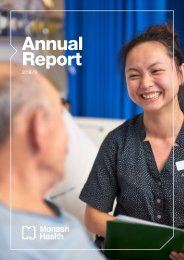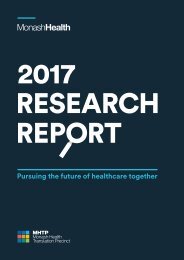Annual Report 2017-18 | Monash Health
Create successful ePaper yourself
Turn your PDF publications into a flip-book with our unique Google optimized e-Paper software.
Note 8.8: AASBs Issued that are not yet effective<br />
Notes to the Financial Statements<br />
<strong>Monash</strong> <strong>Health</strong> <strong>Annual</strong> <strong>Report</strong> <strong>2017</strong>/20<strong>18</strong><br />
Certain new Australian accounting standards have been published that are not mandatory for the 30<br />
June 20<strong>18</strong> reporting period. The Department of Treasury and Finance assesses the impact of all these<br />
new standards and advises <strong>Monash</strong> <strong>Health</strong> of their applicability and early adoption where applicable.<br />
As at 30 June 20<strong>18</strong>, the following standards and interpretations had been issued by the AASB but were<br />
not yet effective. They become effective for the first financial statements for reporting periods<br />
commencing after the stated operative dates as detailed in the table below. <strong>Monash</strong> <strong>Health</strong> has not and<br />
does not intend to adopt these standards early.<br />
Applicable for<br />
annual<br />
reporting<br />
Standard<br />
Summary<br />
periods<br />
beginning on<br />
Impact on public sector entity<br />
financial statements<br />
AASB 9 Financial Instruments The key changes introduced by AASB 9 1 January 20<strong>18</strong> The assessment has identified that the<br />
include simplified requirements for the<br />
classification and measurement of<br />
financial assets, a new hedging<br />
accounting model and a revised<br />
impairment loss model to recognise<br />
impairment losses earlier, as opposed to<br />
the current approach that recognises<br />
impairment only when incurred.<br />
amendments are likely to result in<br />
earlier recognition of impairment<br />
losses and at more regular intervals.<br />
The initial application of AASB 9 is not<br />
expected to significantly impact the<br />
financial positon however there will be<br />
a change to the way financial<br />
instruments are classified and new<br />
disclosure requirements<br />
AASB 2014‐1 Amendments to Australian<br />
Accounting Standards [Part E Financial<br />
Instruments]<br />
AASB 2014‐7 Amendments to Australian<br />
Accounting Standards arising from<br />
AASB 9<br />
AASB 15 Revenue from Contracts with<br />
Customers<br />
AASB 2014‐5 Amendments to Australian<br />
Accounting Standards arising from<br />
AASB 15<br />
Amends various AASs to reflect the<br />
AASB’s decision to defer the mandatory<br />
application date of AASB 9 to annual<br />
reporting periods beginning on or after<br />
1 January 20<strong>18</strong>, and to amend reduced<br />
disclosure requirements<br />
Amends various AASs to incorporate the<br />
consequential amendments arising from<br />
the issuance of AASB 9.<br />
The core principle of AASB 15 requires<br />
an entity to recognise revenue when the<br />
entity satisfies a performance obligation<br />
by transferring a promised good or<br />
service to a customer. Note that<br />
amending standard AASB 2015‐8<br />
Amendments to Australian Accounting<br />
Standards – Effective Date of AASB 15 has<br />
deferred the effective date of AASB 15 to<br />
annual reporting periods beginning on or<br />
after 1 January 20<strong>18</strong>, instead of 1 January<br />
<strong>2017</strong><br />
Amends the measurement of trade<br />
receivables and the recognition of<br />
dividends as follow:<br />
Trade receivables, that do not<br />
have a significant financing<br />
component, are to be measured at<br />
their transaction price at initial<br />
recognition.<br />
Dividends are recognised in the<br />
profit and loss only when:<br />
o the entity’s right to<br />
receive payment of the<br />
dividend is established;<br />
o it is probable that the<br />
economic benefits<br />
associated with the dividend<br />
will flow to the entity; and<br />
1 January 20<strong>18</strong> This amending standard will defer the<br />
application period of AASB 9 to the<br />
20<strong>18</strong>‐19 reporting period in<br />
accordance with the transition<br />
requirements.<br />
1 January 20<strong>18</strong> The assessment has indicated that there<br />
will be no significant impact for the<br />
public sector.<br />
1 January 20<strong>18</strong> The changes in revenue recognition<br />
requirements in AASB 15 may result in<br />
changes to the timing and amount of<br />
revenue recorded in the financial<br />
statements. The Standard will also<br />
require additional disclosures on service<br />
revenue and contract modifications.<br />
1 January 20<strong>18</strong><br />
The assessment has indicated that there<br />
will be no significant impact for the<br />
public sector.<br />
AASB 2015‐8 Amendments to Australian<br />
Accounting Standards – Effective Date of<br />
AASB 15<br />
o the amount can be<br />
measured reliably.<br />
This standard defers the mandatory<br />
effective date of AASB 15 from 1 January<br />
<strong>2017</strong> to 1 January 20<strong>18</strong>.<br />
1 January 20<strong>18</strong> This amending standard will defer the<br />
application period of AASB 15 for forprofit<br />
entities to the 20<strong>18</strong>‐19 reporting<br />
period in accordance with the transition<br />
requirements.<br />
AASB 2016‐3 Amendments to Australian<br />
Accounting Standards – Clarifications to<br />
AASB 15<br />
This Standard amends AASB 15 to clarify<br />
requirements for identifying<br />
performance obligations, principal versus<br />
agent considerations and the timing of<br />
recognising revenue from granting a<br />
licence<br />
The amendments require:<br />
a promise to transfer to a customer<br />
a good or service that is ‘distinct’ to be<br />
recognised as a separate performance<br />
obligation;<br />
for items purchased online, the<br />
entity is a principal if it obtains control of<br />
the good or service prior to transferring<br />
to the customer; and<br />
for licences identified as being<br />
distinct from other goods or services in<br />
a contract, entities need to determine<br />
whether the licence transfers to the<br />
customer over time (right to use) or at a<br />
point in time (right to access).<br />
1 January 20<strong>18</strong><br />
The assessment has indicated that there<br />
will be no significant impact for the<br />
public sector, other than the impact<br />
identified for AASB 15 above.<br />
132 <strong>Monash</strong> <strong>Health</strong> <strong>Annual</strong> <strong>Report</strong> <strong>2017</strong>-<strong>18</strong>








